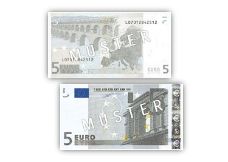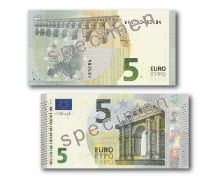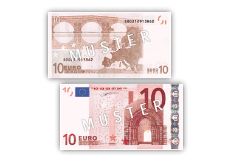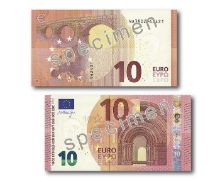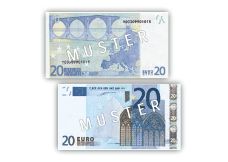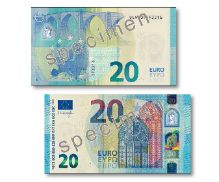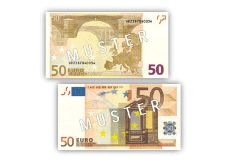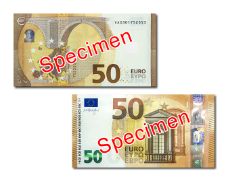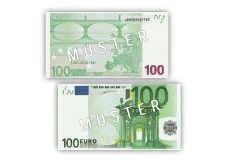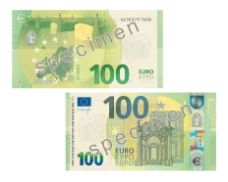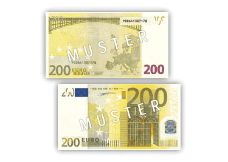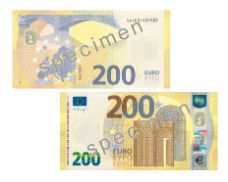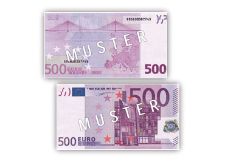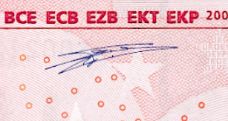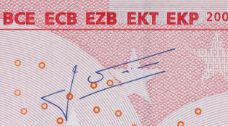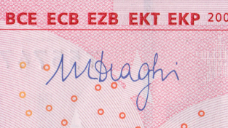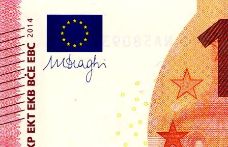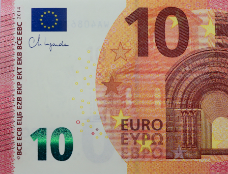Banknotes
Design
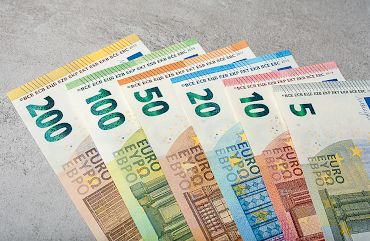
Euro banknotes exist in seven different denominations. Each banknote is associated with a prescribed period and architectural feature in a series depicting the “ages and styles of Europe.” Robert Kalina, a graphic artist at the Oesterreichische Banknoten- und Sicherheitsdruck GmbH in Vienna, designed the banknotes of the first series. The design of the second series was adapted by German graphic artist and designer Reinhold Gerstetter.
The windows and gateways on the front of each banknote symbolize the spirit of openness and cooperation in Europe. The 12 stars of the European Union represent the dynamism and harmony of contemporary Europe. The bridges on the back symbolize communication between the people of Europe and between Europe and the rest of the world.
Every banknote features an architectural style for a different period in Europe’s history. The designs do not show existing structures, but rather architectural styles from various periods.
The technical specifications for the banknotes included a requirement that visually impaired persons be able to handle each banknote with confidence. Therefore, the design was developed in close cooperation with the European Blind Union.
Europa series
On May 2, 2013, the second series of euro banknotes, the Europa series, was launched. Europa, a figure from Greek mythology, is the new face of the euro. Her portrait features on the hologram and in the watermark. The second series of euro banknotes incorporates enhanced security features that draw on advances in banknote security and technology, making the banknotes even more resistant to counterfeiting than the first series. The Europa series continues the “ages and styles” theme of the first series and also features the same main colors as the first series.
The banknotes of the Europa series have been introduced gradually. The EUR 5, 10, 20 and 50 started circulating in 2013, 2014, 2015 and 2017 respectively. The EUR 100 and 200 started circulating on May 28, 2019, which makes the Europa series complete. The EUR 500 is not part of the Europa series, the ECB decided to stop producing the 500 euro banknote.
Banknotes of the first series will remain legal tender, and for the time being, banknotes of both series will continue to circulate in parallel.
Euro banknotes coated for durability
Small denominations of euro banknotes change hands more often because we need them for day-to-day transactions. Before launching the Europa series in 2013, the Eurosystem therefore decided to issue the EUR 5 and EUR 10 banknotes with a protective coating. As shown by tests, such coating helps increase the lifespan of paper money, which, in the long run, saves production costs and resources.
Also relevant for day-to-day transactions, EUR 20 banknotes have likewise come with a special coating since 2020. The coated banknotes tend to be smoother to the touch; otherwise there is no real difference. The changes have not had any impact on banknote checking and cash dispensing machines.
5 euro banknote
The banknote features Classical architecture.
Color: Gray
Size: 120 x 62 x 0.12 mm
Weight: 0.6 g
10 euro banknote
The banknote features Romanesque architecture.
Color: Red
Size: 127 x 67 x 0.12 mm
Weight: 0.7 g
20 euro banknote
The banknote features Gothic architecture.
Color: Blue
Size: 133 x 72 x 0.12 mm
Weight: 0.8 g
50 euro banknote
The banknote features Renaissance architecture.
Color: Orange
Size: 140 x 77 x 0.12 mm
Weight: 0.9 g
100 euro banknote
The banknote features Baroque and rococo architecture.
Color: Green
Size: 147 x 82 x 0.12 mm; Europa series: 147 x 77 x 0.12 mm
Weight: 1.0 g
200 euro banknote
The banknote features 19th century iron and glass architecture.
Color: Yellow-brown
Size: 153 x 82 x 0.12 mm; Europa series: 153 x 77 x 0.12 mm
Weight: 1.1 g
500 euro banknote
The banknote features 20th century architecture.
Color: Purple
Size: 160 x 82 x 0.12 mm
Weight: 1.1 g
Different signatures
Euro banknotes are signed either by Willem F. Duisenberg, Jean-Claude Trichet, Mario Draghi or Christine Lagarde – the first, second, third and fourth Presidents of the ECB, respectively. All banknotes are equally valid regardless of whose signature is shown.

